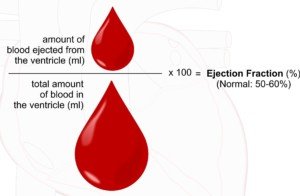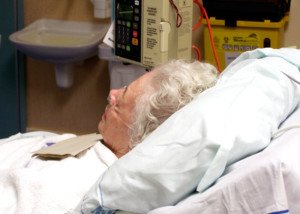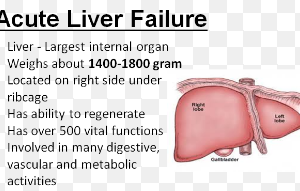Do elderly people in various age brackets have an associated “normal” ejection fraction?
For example, what is the expected or normal ejection fraction for the typical elderly person between 80 and 89?
And how about between 70 and 79?
How about 90+?
Definition of Ejection Fraction
This is the percentage of blood that is pumped or ejected out of the heart with each beat.
Two people with the same ejection fraction don’t necessarily get the same volume of blood being pumped out with each beat.
This is because the ejected percentage is relative to the amount of blood that the heart fills with before each beat.
Thirty percent of two different filling volumes in two different hearts is not the same amount of blood being pumped out for those two hearts if those hearts fill with different amounts of blood prior to each beat.

Shutterstock/ellepigrafica
To put this simply, imagine that one-third of a cup of water is being expelled, and then one-third of a gallon of water is being expelled.
In both cases, the “ejection” is 30%, but the net ejected water is much greater when it comes from the gallon than from the cup.
Ejection Fractions of Various Age Ranges of the Elderly
“Normal ejection fraction is between 55-70%,” says Waqar Khan, MD, who’s been providing state-of-the-art cardiology services to the Houston area for over 20 years, and is author of “Be Heart Smart: Understand, Treat, and Prevent Coronary Heart Disease.”
The “normal” here refers to a normal or healthy function – regardless of the patient’s age.
“It’s not really affected by age,” says Dr. Khan. “Left ventricular ejection fraction is the ability of the left ventricle or the left chamber of the heart to contract.
“Normally the left chamber pumps oxygenated blood to various organs of the body.
“This ability of the heart to squeeze blood is reduced in many cases of heart attack as well as diseases of the heart muscle.”
The heart muscle may become altered in shape due to chronic high blood pressure.
This alteration in shape will impair the efficacy of the heart’s pumping action, leading to a condition called chronic heart failure. This influences ejection fraction.
“A normal ejection fraction is typically above 55%,” says Dr. Khan.
“I tell my patients this is not like your high school English test where you need to score a 100%.”
Ejection Fraction and Age

Freepik.com
Dr. Khan says, “It’s abnormal for someone to have an ejection fraction that’s more than 90%.
“Most individuals young or old have an ejection fraction between 55 to 70%.”
This is an average for people of any age in general.
Now if you have a room full of people of elderly or even middle age, who all have been diagnosed with chronic heart failure — and all of their ejection fractions are measured via echocardiogram – certainly the average range of percentage is going to be below 50 percent.
• Chronic heart failure affects many people under age 65.
• Conversely, many people of senior age do not have chronic (formally known as “congestive”) heart failure – meaning, ejection fractions in the normal range of 55 to 70%.
• There are no studies that have determined what the “average” ejection fraction would be of any random large group of people in any particular age bracket, let alone over age 65.
A person who’s 92 and still functioning fairly well (albeit requiring a cane), most likely would not have tested positive for chronic heart failure (e.g., ejection fraction of 35%) at the age of 84.
It’s possible, but not likely, since this disease is progressive and often results in death within eight years of diagnosis (depending on the cause, such as coronary heart disease).
Conversely, person with chronic heart failure from coronary artery disease (and hence, reduced ejection fraction) at the age of 50 probably won’t see their 85th birthday.

Waqar Khan, MD, has a private practice and serves as an affiliate faculty member at Baylor College of Medicine in Houston, TX. Amazon.com/Be-Heart-Smart-Understand-Coronary/dp/1732268606
 Lorra Garrick has been covering medical, fitness and cybersecurity topics for many years, having written thousands of articles for print magazines and websites, including as a ghostwriter. She’s also a former ACE-certified personal trainer.
Lorra Garrick has been covering medical, fitness and cybersecurity topics for many years, having written thousands of articles for print magazines and websites, including as a ghostwriter. She’s also a former ACE-certified personal trainer.
.










































